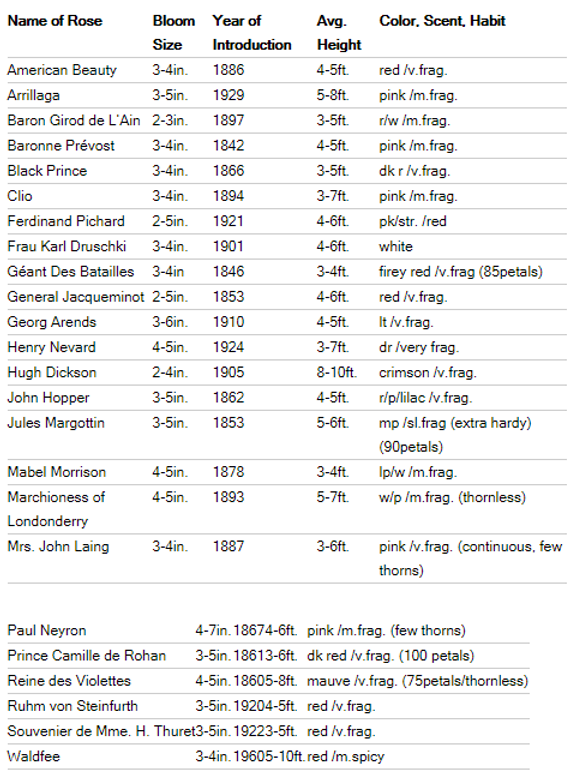Gone are the heavy Victorian furniture, beaded curtains and Tiffany lamps of the 18th Century. Along with them, the rose rage of the season, the hybrid perpetual, slipped almost unnoticed into obscurity and near extinction. Out of the nearly 3,000 varieties hybridized during this golden age, we have only about 100 left, and only about 50 varieties are commercially available today.
While they were in vogue, they were very popular as people rushed to include the newest variety in their garden. But by the beginning of the 1900′s, interest had already begun to wane.
Introduced in France in 1837, as ‘hybrid remontant’, they were later referred to as hybrid perpetuals. Perpetual was a real misnomer since their recurrent bloom was still only twice seasonally – still more flowers than produced by their illustrious genetic ancestors, the damasks, hybrid chinas and bourbons. Their most important contribution to the rose world was their winter hardiness, a great improvement over their winter tender parents, and a hardiness that still exceeds the modern hybrid tea roses that usurped their place in rose gardens.
The bushes are vigorous growers, having tall canes with an upright growth habit. Some varieties have extra long canes, and the overall appearance is improved by ‘pegging down’. The foliage for the most part is dull, wrinkled, although some varieties have blue-green leaves while others have shiny smooth leaves, and some are nearly thornless.
The many-petaled flowers are usually very fragrant and run the gamut of color from purest white, to pink, red and deepest maroon. Some varieties are edged or splashed with white or deep maroon. Interestingly enough, with the wide range of color shades, there were no yellows.
In 1867, the first hybrid tea, ‘La France‘, was introduced, and it signaled a definite death knell for these Victorian beauties. The hybrid tea supplied the abundant, recurrent bloom that had been awaited for so many years. But along the way we sacrificed the lovely, many-petaled form and unmatchable fragrance. The second part of the search for a more improved rose was fulfilled in that the blooms of the hybrid tea also supplied a broader color range.
Many of our modern roses trace their color and/or form to their illustrious hybrid perpetual ancestors. To its other many virtues, ‘General Jacqueminot’, was to add what to the rose breeder is the cardinal virtue – the ability to transmit its good characteristics both as a prolific pollinator and seed parent. So successful was it in this role that there were probably 520 recorded roses directly descended from it, and there are, in addition, hundreds of other unrecorded crosses. For nearly 60 years this rose was the standard of comparison among red roses.
‘Paul Neyron‘, with pink blooms upwards to seven inches, is the perfect embodiment of a cabbage rose–big, full of petals, rather flat (saucer-shaped) when open. ‘Prince Camille de Rohan‘ was another masterpiece with its bloom of over 100 velvety, dark red petals.
For many years the rage of the florist trade was ‘Mme Ferdinand Jamin‘ introduced in 1886 under the name ‘American Beauty‘. And finally, the superb, pure white ‘Frau Karl Druschki‘, although introduced in 1901, can still thrill gardeners with her flawless flowers perfectly showcased against blue-green foliage. On a historical note, ‘Frau Karl Druschki‘ is also known by the name of ‘Reine des Neiges‘, ‘Snow Queen‘ and ‘White American Beauty‘ – any one of which names would be regarded by most as more descriptively suitable than that of the wife of the then president of the German Rose Society. However, by quite undeservedly failing to win in 1900 a competition for the best unnamed seedling of German origin, this chaste white beauty escaped the compulsory condition of being named ‘Otto von Bismark‘.
While many of the varieties are rather tall plants, most varieties are in the three to five foot range and adapt well to modern gardens and landscapes. By placing them in the back, their height and coloration adds an interesting foil for the shorter plants, and their absence of continual bloom is not a glaring fault.
Limited space does not allow us to delve any more deeply into this fascinating area, but I would like to include a few names and descriptions of some noteworthy hybrid perpetuals that are still available.





























































